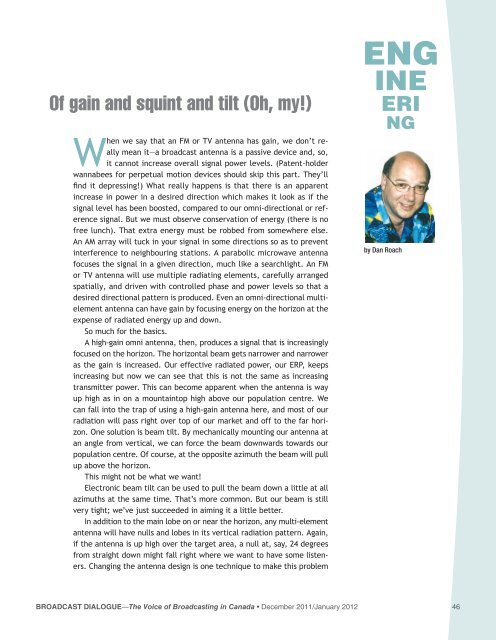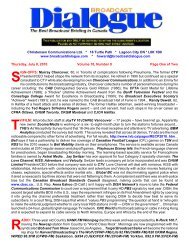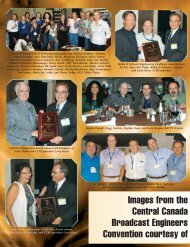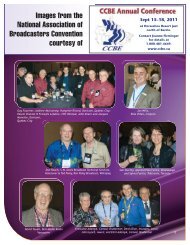Current PDF Edition - Broadcast Dialogue
Current PDF Edition - Broadcast Dialogue
Current PDF Edition - Broadcast Dialogue
Create successful ePaper yourself
Turn your PDF publications into a flip-book with our unique Google optimized e-Paper software.
Of gain and squint and tilt (Oh, my!)<br />
When we say that an FM or TV antenna has gain, we don’t really<br />
mean it—a broadcast antenna is a passive device and, so,<br />
it cannot increase overall signal power levels. (Patent-holder<br />
wannabees for perpetual motion devices should skip this part. They’ll<br />
find it depressing!) What really happens is that there is an apparent<br />
increase in power in a desired direction which makes it look as if the<br />
signal level has been boosted, compared to our omni-directional or reference<br />
signal. But we must observe conservation of energy (there is no<br />
free lunch). That extra energy must be robbed from somewhere else.<br />
An AM array will tuck in your signal in some directions so as to prevent<br />
interference to neighbouring stations. A parabolic microwave antenna<br />
focuses the signal in a given direction, much like a searchlight. An FM<br />
or TV antenna will use multiple radiating elements, carefully arranged<br />
spatially, and driven with controlled phase and power levels so that a<br />
desired directional pattern is produced. Even an omni-directional multielement<br />
antenna can have gain by focusing energy on the horizon at the<br />
expense of radiated energy up and down.<br />
So much for the basics.<br />
A high-gain omni antenna, then, produces a signal that is increasingly<br />
focused on the horizon. The horizontal beam gets narrower and narrower<br />
as the gain is increased. Our effective radiated power, our ERP, keeps<br />
increasing but now we can see that this is not the same as increasing<br />
transmitter power. This can become apparent when the antenna is way<br />
up high as in on a mountaintop high above our population centre. We<br />
can fall into the trap of using a high-gain antenna here, and most of our<br />
radiation will pass right over top of our market and off to the far horizon.<br />
One solution is beam tilt. By mechanically mounting our antenna at<br />
an angle from vertical, we can force the beam downwards towards our<br />
population centre. Of course, at the opposite azimuth the beam will pull<br />
up above the horizon.<br />
This might not be what we want!<br />
Electronic beam tilt can be used to pull the beam down a little at all<br />
azimuths at the same time. That’s more common. But our beam is still<br />
very tight; we’ve just succeeded in aiming it a little better.<br />
In addition to the main lobe on or near the horizon, any multi-element<br />
antenna will have nulls and lobes in its vertical radiation pattern. Again,<br />
if the antenna is up high over the target area, a null at, say, 24 degrees<br />
from straight down might fall right where we want to have some listeners.<br />
Changing the antenna design is one technique to make this problem<br />
ENG<br />
INE<br />
ERI<br />
NG<br />
by Dan Roach<br />
BROADCAST DIALOGUE—The Voice of <strong>Broadcast</strong>ing in Canada • December 2011/January 2012 46

















